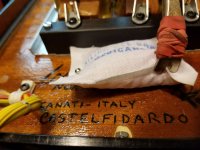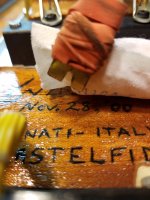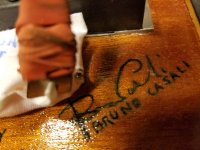tailwheelpilot
Member
Greetings, all!
I'm a long-term accordion enthusiast, 50+ years and counting, still not a very advanced player (consider myself a relative beginner), seeking advice:
I already have two accordions that I love, a Concerto from Accordions International (Hi Paul!), and a Borsini Professional Line Super Star, both with moderate tremolo in the 11 to 15 cents range, maybe a little less. [Parenthetically, my Borsini was played by Cory Pesaturo on a David Letterman show with Johnny Depp in about 2013 (Hi Cory!)]
(Hi Cory!)]
I'm in the process of getting a custom accordion, need to specify the tuning to get a very warm and mellow tone, without the tone announcing "hey, I'm an accordion", something not as bright as the tone of the accordions I have, which also I adore, BTW. It does not have to be unison tuned, which I gather can be less versatile for playing different genres.
I've scoured the web for recordings that compare different tunings, found a few on various sites and YouTube, but still nothing that would enable me to hear the difference in the "very slightly wet" tuning range of 2 to 5 cents.
1. Would very much appreciate any pointers or links to audio files I could listen to;
2. If one is going for, say, 3 cents wet tuning on an LMMH accordion with tone chambers, would it make an audible difference whether the detuned reed set is 3 cents flat, versus 3 cents sharp?
3. Is something like 2 cents even perceptible? I gather that a little bit of wet tuning, something non-zero, adds a "sweetness" to the tone that purely dry tuning does not have.
and
4. Why would one go for 442 Hz tuning for A4 instead of the "standard" 440 Hz?
The intended use of this accordion would be for what in singing would be called "bel canto"-type music, if you get my drift, not hard-core classical, but perhaps towards the light classical repertoire, Latin classics (Besame Mucho), and Neapolitan songs with a softer, warmer sound than I get from the two accordions I have.
I'm not likely to play in an ensemble, so this is for solo use, or maybe to accompany my daughter's singing.
Any guidance from your experience would be very greatly appreciated, as this custom accordion will likely be the last one I get to last me the rest of my life!
Many thanks,
Inder
I'm a long-term accordion enthusiast, 50+ years and counting, still not a very advanced player (consider myself a relative beginner), seeking advice:
I already have two accordions that I love, a Concerto from Accordions International (Hi Paul!), and a Borsini Professional Line Super Star, both with moderate tremolo in the 11 to 15 cents range, maybe a little less. [Parenthetically, my Borsini was played by Cory Pesaturo on a David Letterman show with Johnny Depp in about 2013
I'm in the process of getting a custom accordion, need to specify the tuning to get a very warm and mellow tone, without the tone announcing "hey, I'm an accordion", something not as bright as the tone of the accordions I have, which also I adore, BTW. It does not have to be unison tuned, which I gather can be less versatile for playing different genres.
I've scoured the web for recordings that compare different tunings, found a few on various sites and YouTube, but still nothing that would enable me to hear the difference in the "very slightly wet" tuning range of 2 to 5 cents.
1. Would very much appreciate any pointers or links to audio files I could listen to;
2. If one is going for, say, 3 cents wet tuning on an LMMH accordion with tone chambers, would it make an audible difference whether the detuned reed set is 3 cents flat, versus 3 cents sharp?
3. Is something like 2 cents even perceptible? I gather that a little bit of wet tuning, something non-zero, adds a "sweetness" to the tone that purely dry tuning does not have.
and
4. Why would one go for 442 Hz tuning for A4 instead of the "standard" 440 Hz?
The intended use of this accordion would be for what in singing would be called "bel canto"-type music, if you get my drift, not hard-core classical, but perhaps towards the light classical repertoire, Latin classics (Besame Mucho), and Neapolitan songs with a softer, warmer sound than I get from the two accordions I have.
I'm not likely to play in an ensemble, so this is for solo use, or maybe to accompany my daughter's singing.
Any guidance from your experience would be very greatly appreciated, as this custom accordion will likely be the last one I get to last me the rest of my life!
Many thanks,
Inder






